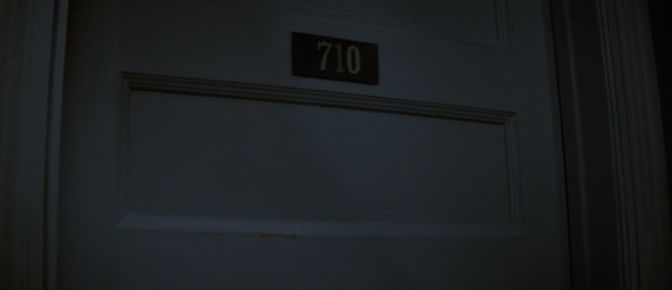 Back to selection
Back to selection
The Blue Velvet Project
Blue Velvet, 47 seconds at a time by Nicholas Rombes
The Blue Velvet Project, #42

Second #1974, 32:54
What does it mean to speak of the cinematic image in the age of cinematic images? This frame, captured from the 2002 DVD edition of Blue Velvet, isn’t really even a frame; its relationship to the 35 mm source film is ambiguously fraught with the complications of digital coding. For one thing, if the film has been MPEG-2 compressed, what has been lost? The information in the frame leaks in and out, depending on our viewing medium of choice, so that we experience the digital image not so much through presence, but through absence. Spatial and temporal compression: the door to Dorothy’s apartment, the carved-out rectangle beneath #710 like a movie screen within the frame. In The Vision Machine, Paul Virilio writes that
sight comes from a long way off. It is a kind of dolly in, a perceptual sctivity that starts in the past in order to illuminate the present, to focus on the object of our immediate perception. The space of sight is accordingly not Newton’s space, absolute space, but Minkowskian event-space, relative space. And it is not only the dim brightness of these stars that comes to us from out of the distant past, out of the mists of time. The weak light that allows us to apprehend the real, to see and understand our present environment, itself comes from a distant visual memory without which there would be no act of looking.
What to do with the terrifying and beautiful fact that the very light that allows us to observe the present is itself from the past? On one level, Lynch’s films—especially Blue Velvet, Twin Peaks: Fire Walk With Me, Mulholland Drive, and most radically Inland Empire—present their own special theories of relativity, where time and space fold together, and enfold us.
Over the period of one full year — three days per week — The Blue Velvet Project will seize a frame every 47 seconds of David Lynch’s classic to explore. These posts will run until second 7,200 in August 2012. For a complete archive of the project, click here. And here is the introduction to the project.
